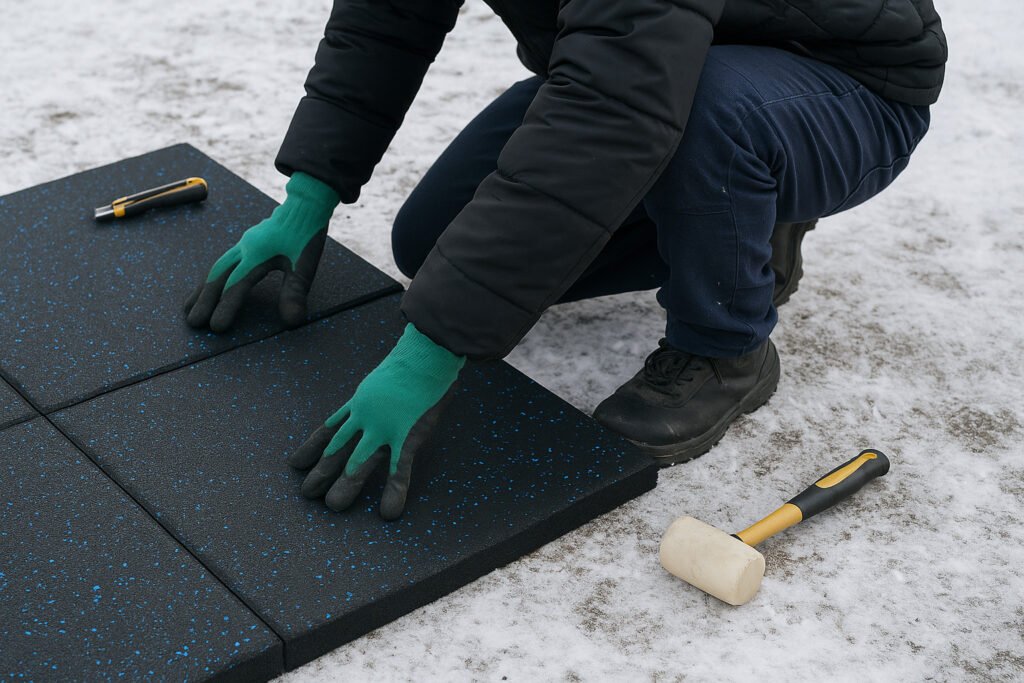Rubber Flooring Cold Weather Installation: Can It Be Done Safely?
Rubber flooring cold weather installation is absolutely possible — but only when the right preparation steps are followed. Cold temperatures can cause adhesives to fail, rubber to shrink, and bonding to weaken. Here’s what you need to know before laying rubber floors in winter.

How Cold Temperatures Affect Rubber Flooring Installation
Winter slows down everything — and rubber is no exception. Here’s how cold impacts both materials and adhesives during installation.
Common Effects of Cold Weather
- Rubber stiffens and shrinks – making it harder to interlock or lay flat
- Adhesives lose tack – cure times extend or fail entirely
- Subfloors trap condensation – this may ruin bonding and cause mold
| Factor | Warm Weather | Cold Weather |
|---|---|---|
| Rubber Flexibility | High | Low |
| Adhesive Bonding | Quick dry | Slow or weak |
| Subfloor Risk | Minimal | Condensation possible |
According to ASTM F710 standards, proper acclimation and subfloor prep are essential for resilient flooring installation, especially in low-temperature environments.
Best Practices for Cold-Weather Rubber Flooring Installation
- Acclimate materials indoors for 24–48 hours at 18–25°C before installation
- Heat the room to at least 15°C during install and curing
- Use cold-rated adhesives or tape — or switch to interlocking options
- Dry the subfloor completely to avoid condensation issues
- Leave a 3–5mm expansion gap to allow for future movement
Best Lanhefloor Products for Winter Installation
Interlocking Rubber Tile
- No adhesive required
- Flexible and cold-friendly
- Great for temporary or modular areas
Rubber Roll
- Covers large areas quickly
- Use with tape or glue
- Recommended for offices or cardio areas
Tiny Granules Rubber Tile
- Dense and durable
- Needs acclimation before install
| Product | Winter Suitability | Why |
|---|---|---|
| Interlocking Tile | ★★★★★ | Glue-free, flexible |
| Rubber Roll | ★★★★☆ | Less glue, faster setup |
| Tiny Granule Tile | ★★☆☆☆ | Heavy, rigid when cold |
Extra Tip: Let the Floor Acclimate!
When doing a rubber flooring cold weather installation, always store materials indoors 48 hours ahead. This allows proper expansion and helps avoid gapping or lifting once room temperatures stabilize.
Common Winter Installation Mistakes to Avoid
- ❌ Skipping acclimation – leads to shrinkage or tile buckling
- ❌ Using adhesives below minimum temperature rating
- ❌ Laying over moist or frozen concrete
- ❌ Forgetting expansion gaps at walls or corners
Related Pages and Resources
FAQs: Rubber Flooring Cold Weather Installation
Can rubber flooring be installed in winter?
Yes, with proper heating, acclimation, and dry subfloors, cold weather installs are safe and effective.
Which products are best for winter flooring installation?
Interlocking tiles and rubber rolls work best — they require minimal adhesive and offer flexibility.
What temperature should rubber flooring adhesives be used at?
Typically 10–15°C minimum. Check your adhesive label or consult the manufacturer.
Does rubber flooring crack in cold weather?
No, but it becomes stiff and harder to work with — proper prep prevents cracking or gaps.
How long should rubber flooring acclimate before winter installation?
At least 24–48 hours in a heated space (ideally 18–25°C).
Need installation advice or cold-weather ready flooring? Contact Lanhefloor for technical support and B2B pricing.
